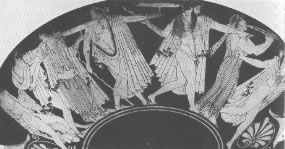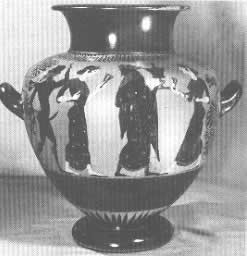The
political and social components of the symposium In Athens, there was an important distinction between the oikos, household, and the polis, city. The private sphere and the public arena were two distinct entities. However through gatherings such as the symposium, both spheres could interact and in a sense the public world of the city reached into the house, where symposia were held. A man's drinking companions were the friends with whom he associated during the day in assembly, market place and gymnasium. They would be men of the same age, with whom he had gone to school, been initiated to a phratry and served as a soldier. The symposium would bring the men together in a sort of brotherhood or companionship known as the hetaireia. Participation in the symposium could reflect participation in public spheres of Greek life. The social and political roles of men and women were reflected in the symposium in terms of education, socializing and creating ties. The symposium was the setting for males in their social roles, it was important for their education and for the creation of their personal ties to a specific group of men. There was a great sense of loyalty and obligation to one's sympotic group. The competitive aspects of the polis life were strongly present in the symposium and it also mirrored some formal procedures of the city: secret ballot to decide the result of a speech-making competition, election of a president for drinking contests. The gymnastic contests in physical agility, which were so much part of public life, were represented by competitions in maintaining physical control when drunk. The ordinary symposium parodied the life of assembly and gymnasium by challenging the participants to display their rhetorical and physical skills on frivolous subjects and in comical dances. The symposium can therefore be seen as a reflection of the important aspects of the male social and political responsibilities.
It is clear that the symposium was not in itself created and maintained for political reasons. It served as a drinking party and as entertainment. However from the congregation of men who had special bonds and relationships, alliances could be made and contests for offices could emerge. We know also that some of the sympotic songs had political connotations and references. The symposium on its own was generally just a party but within the social and political structure of the Greek world it served as an important means for making crucial connections. The symposium was also an institution which preserved privilege and demonstrated wealth and power. Essential aspects of the symposium were formed at the time of Homer with the shared festivity of the ruling, prosperous elite. Its development in the archaic age, visible in the lyric and iambic poetry of Alcaeus, Alcman and others, saw it firmly established an expression of solidarity among the wealthy nobility and throughout the classical period, the symposium retained its elitist associations. By the late 5th century, the Athenian men seemed to be increasingly socializing into the attitudes of an exclusive, rebellious and alienated elite. Thucydides saw the symposium as an engine which powered the political agenda of oligarchic groups. In his discussion of the stasis in book III.82, he mentions such groups as a key source of political fragmentation, and he is explicit in book VIII.54 that they were formed for the purpose of influencing policy and the outcome of trials. The scandal of 415 BC,
with the mutilation of the Hermae, exposed the covert mistrust surrounding
the sympotic groups. The mutilation was seen by the angry populace
as 'evidence of a revolutionary conspiracy to overthrow democracy'
(Thucydides VI.28) and linked to symposia, notably though Alcibiades. Research by the whole group. Text by Laure Kellens |

 However
there was still a marked distinction between public interaction
and meetings in an oikos. Political meetings held in private houses
were generally associated with conspiracy. The symposium was thus
not the place for serious talk about politics or even about philosophy.
In Plato's Symposium, the subject of discussion is love. Other suitable
topics for discussion found in Xenophon's Symposium include: dancing,
perfume, the education of women, drinking, etc. The ties and indeed
love between a mature man and a younger male formed in the symposium,
were valued for their function in education and socializing. Possibly
like a rite of passage, the symposium played an important role in
the progress of young men towards public activity, since a boy would
be introduced to adult society by an older lover who took his father's
place as a model of adult behavior.
However
there was still a marked distinction between public interaction
and meetings in an oikos. Political meetings held in private houses
were generally associated with conspiracy. The symposium was thus
not the place for serious talk about politics or even about philosophy.
In Plato's Symposium, the subject of discussion is love. Other suitable
topics for discussion found in Xenophon's Symposium include: dancing,
perfume, the education of women, drinking, etc. The ties and indeed
love between a mature man and a younger male formed in the symposium,
were valued for their function in education and socializing. Possibly
like a rite of passage, the symposium played an important role in
the progress of young men towards public activity, since a boy would
be introduced to adult society by an older lover who took his father's
place as a model of adult behavior.